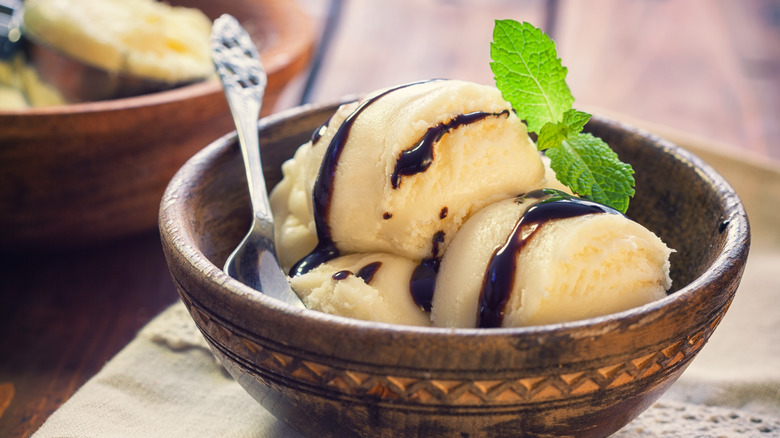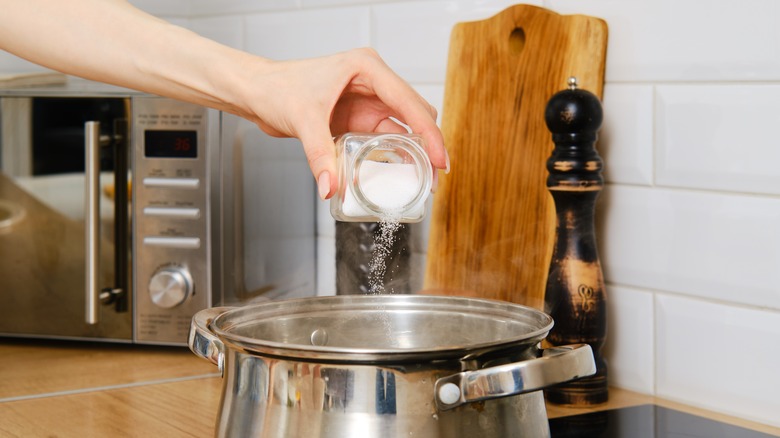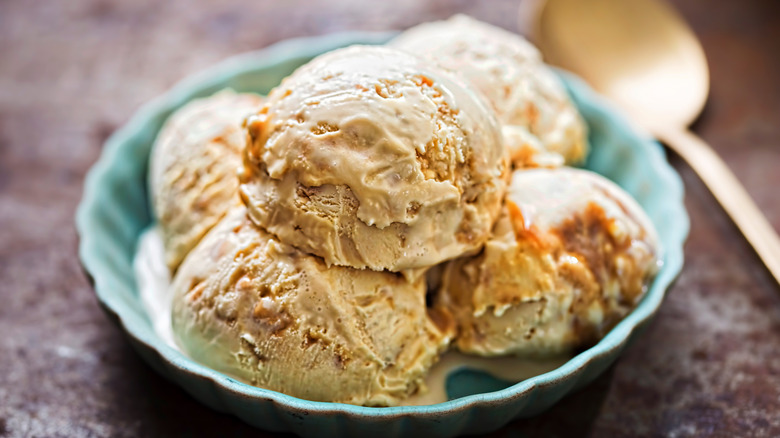Add Salt To Your Homemade Ice Cream And Taste The Difference
If you want to completely customize your dessert experience, making homemade ice cream can be a great way to mix up delicious and unique flavors, from peanut butter and strawberry jam to langkasuy (jackfruit and cashew). However, no matter what flavor you're making, you should never be afraid to add a little salt to your ice cream base. While you could always sprinkle some salt on top of the final result, actually mixing it into the ice cream base can greatly benefit the dessert's flavor.
For any ice cream flavor besides salted caramel, salt may seem like an unusual addition. But salt does more than make things taste salty — even in small amounts, it enhances the flavors of any food it touches, including sweets. Sweet-and-salty snacks like chocolate pretzels are an obvious example, but cake and cookie recipes often include salt in the batter to provide more depth of flavor. It balances out the sweetness of the dessert without adding an overwhelming salty note, and the same concept can enhance your homemade ice cream, too.
Using a bigger amount of salt for a savory edge could be a welcome contrast to ultra-sweet flavors of the ice cream, while a sparing amount makes any kind of flavor sing. If you want some extra texture, try mixing in flaky sea salt for a little bit of crunch. The one factor to be careful with is the quantity of salt you use, but a few simple guidelines can help you out.
How much salt should you add to ice cream?
While salt may be a welcome contrast to sweet ice cream, make sure you don't overdo it. For every gallon of ice cream you plan to make, start with about 1 ½ teaspoons of salt. If you want salt at the forefront of the dessert's flavor, try adding up to a tablespoon. Sweet and simple flavors like chocolate, peanut butter, and (of course) caramel may benefit a from a slightly larger quantity of salt, to cut through the richness and add dimension to the sugary taste.
If you'd rather make a smaller batch of ice cream to test this concept out, a ½ pint ice cream recipe will only require about ⅛ teaspoon of salt. In any case, add salt a little at a time, and don't be too generous the very first time you try it. Taste the final ice cream and adjust the quantity of salt the next time you make it, according to your tastes.
If you want the flavor of salt to be spread evenly throughout your batch of ice cream, add it into the recipe early to make sure it fully dissolves. Simply mix it into the milk, cream, eggs, sugar, and flavorings in your ice cream base and cook over the stovetop before churning. If you want more obvious pops of salt in contrast to sweeter bites of ice cream, mix the salt in right after the base has been cooked, before churning.
Salty additions to complement your ice cream
If you end up really enjoying your slightly salty ice cream, different toppings and flavorings can enhance the effect. Homemade caramel with a pinch of salt can be mixed into your ice cream before you stick it in the freezer, creating sweet and salty ribbons throughout your scoops. You could also drizzle in some melted peanut butter. Most brands of PB have salt in them, so it pairs deliciously with lightly salted chocolate or vanilla ice cream.
To really get creative with your frozen desserts, try swapping out plain old salt for other sources of salty flavor. Try adding a splash of soy sauce to ice creams with warm honey, brown sugar, or caramel notes. It sounds strange, but the sauce provides a unique umami flavor that adds even more dimension and contrast. A little bit of your favorite hot sauce could also add a pleasant and unexpected kick of savory spice to creamy ice cream.
If you like some extra texture in your scoops, add crushed pretzels or potato chips to your base for both saltiness and crunch (like in this strawberry pretzel ice cream). Toppings like bacon bits or even wasabi peas can take your taste buds on a ride of salty, sweet, creamy, and crispy elements. No matter if you add a little or a lot of salt to your ice cream, it will always taste better than it would without it.


